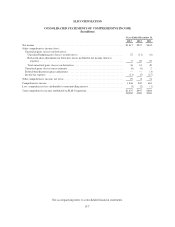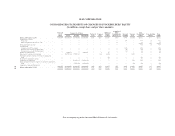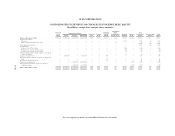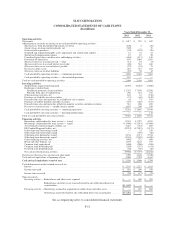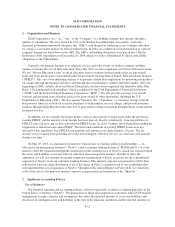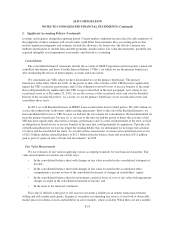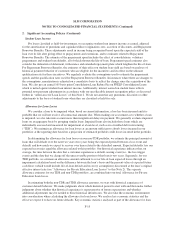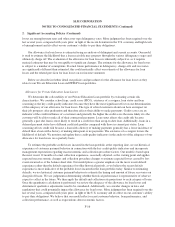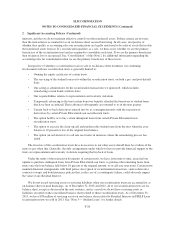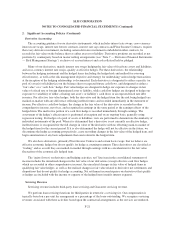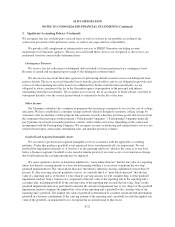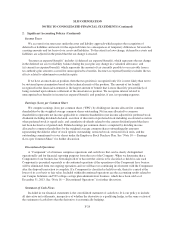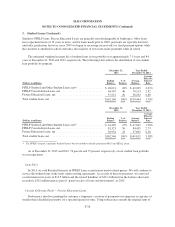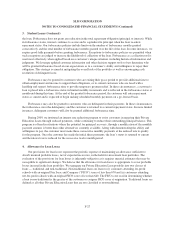Sallie Mae 2013 Annual Report Download - page 155
Download and view the complete annual report
Please find page 155 of the 2013 Sallie Mae annual report below. You can navigate through the pages in the report by either clicking on the pages listed below, or by using the keyword search tool below to find specific information within the annual report.SLM CORPORATION
NOTES TO CONSOLIDATED FINANCIAL STATEMENTS (Continued)
2. Significant Accounting Policies (Continued)
Similar to the rules governing FFELP payment requirements, our collection policies allow for periods of
nonpayment for customers requesting additional payment grace periods upon leaving school or experiencing
temporary difficulty meeting payment obligations. This is referred to as forbearance status and is considered
separately in our allowance for loan losses. The loss confirmation period is in alignment with our typical
collection cycle and takes into account these periods of nonpayment.
On July 1, 2011, we adopted new guidance that clarified when a loan restructuring constitutes a TDR. In
applying the new guidance we determined that certain Private Education Loans for which we grant forbearance
of greater than three months should be classified as TDRs. If a loan meets the criteria for troubled debt
accounting then an allowance for loan losses is established which represents the present value of the losses that
are expected to occur over the remaining life of the loan. This accounting results in a higher allowance for loan
losses than our previously established allowance for these loans as our previous allowance for these loans
represented an estimate of charge-offs expected to occur over the next two years (two years being our loss
confirmation period). The new accounting guidance was effective as of July 1, 2011 but was required to be
applied retrospectively to January 1, 2011. This resulted in $124 million of additional provision for loan losses in
the third quarter of 2011 from approximately $3.8 billion of student loans being classified as TDRs. This new
accounting guidance is only applied to certain customers who use their fourth or greater month of forbearance
since the time period this new guidance is effective. This new accounting guidance has the effect of accelerating
the recognition of expected losses related to our Private Education Loan portfolio. The increase in the provision
for losses as a result of this new accounting guidance does not reflect a decrease in credit expectations of the
portfolio or an increase in the expected life-of-loan losses related to this portfolio. We believe forbearance is an
accepted and effective collection and risk management tool for Private Education Loans. We plan to continue to
use forbearance and as a result, we expect to have additional loans classified as TDRs in the future (see “Note 4
— Allowance for Loan Losses” for a further discussion on the use of forbearance as a collection tool).
As part of concluding on the adequacy of the allowance for loan losses, we review key allowance and loan
metrics. The most relevant of these metrics considered are the allowance coverage of charge-offs ratio; the
allowance as a percentage of total loans and of loans in repayment; and delinquency and forbearance percentages.
Certain Private Education Loans do not require customers to begin repayment until six months after they
have graduated or otherwise left school. Consequently, our loss estimates for these programs are generally low
while the customer is in school. At December 31, 2013, 17 percent of the principal balance in the higher
education Private Education Loan portfolio was related to customers who are in an in-school/grace/deferment
status and not required to make payments. As this population of customers leaves school, they will be required to
begin payments on their loans, and the allowance for loan losses may change accordingly.
We consider a loan to be delinquent 31 days after the last payment was contractually due. We use a model to
estimate the amount of uncollectible accrued interest on Private Education Loans and reserve for that amount
against current period interest income.
In general, Private Education Loan principal is charged off against the allowance when at the end of the
month the loan exceeds 212 days past due. The charged-off amount equals the estimated loss of the defaulted
loan balance. Actual recoveries, as they are received, are applied against the remaining loan balance that was not
charged off. If periodic recoveries are less than originally expected, the difference results in immediate additional
provision expense and charge-off of such amount.
Our allowance for Private Education Loan losses also provides for possible additional future charge-offs
related to the receivable for partially charged-off Private Education Loans. At the end of each month, for loans
that are 212 days past due, we charge off the estimated loss of a defaulted loan balance. Actual recoveries are
F-17


